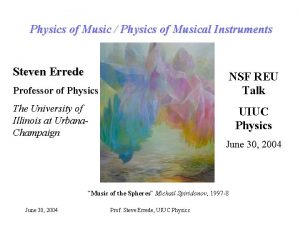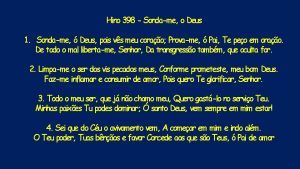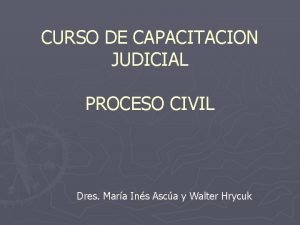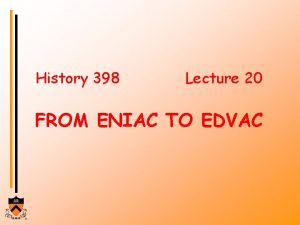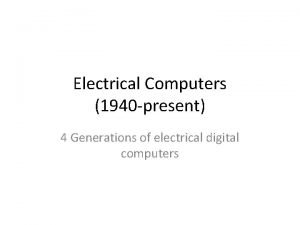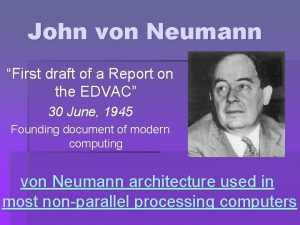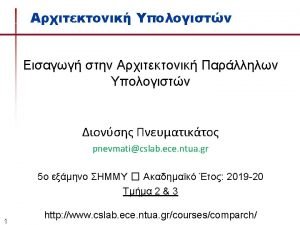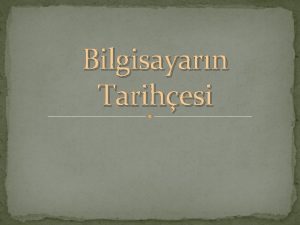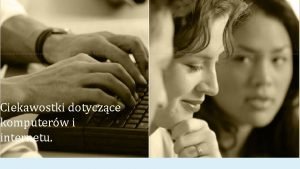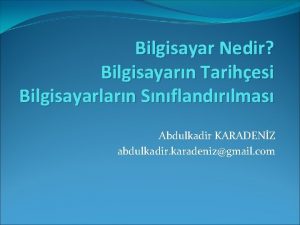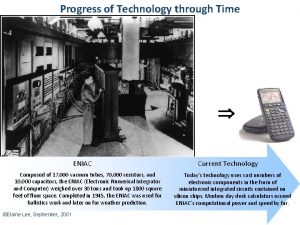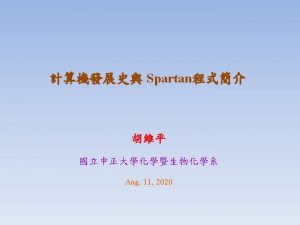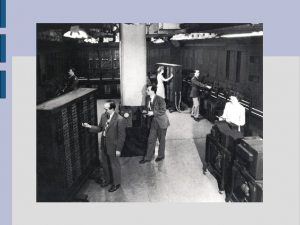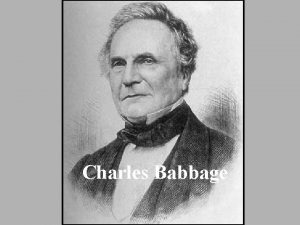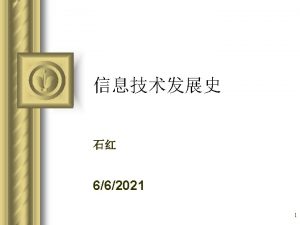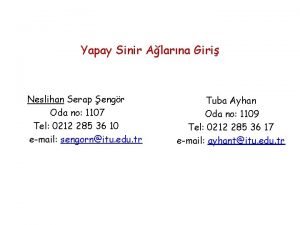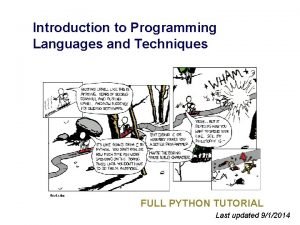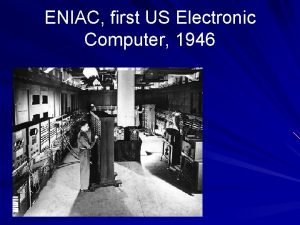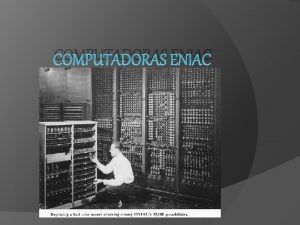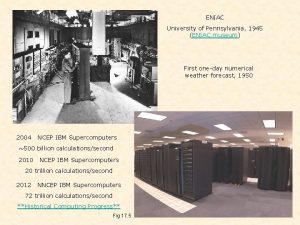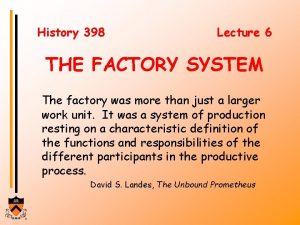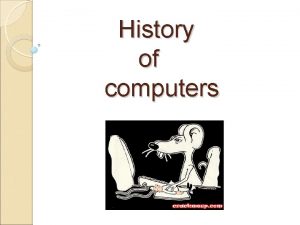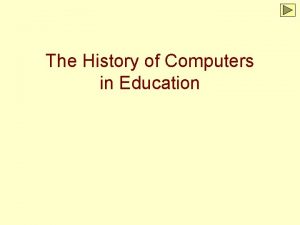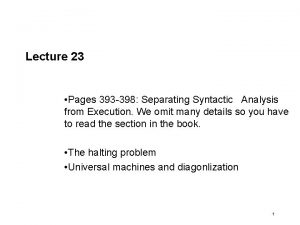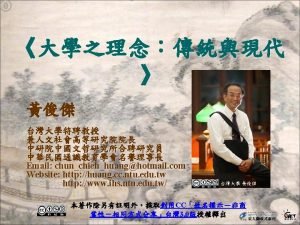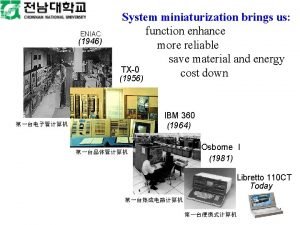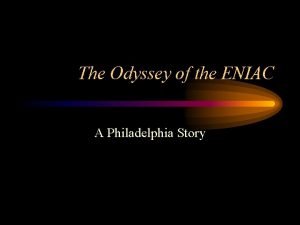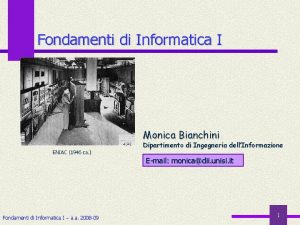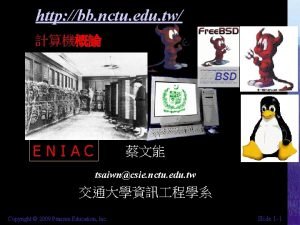History 398 Lecture 20 FROM ENIAC TO EDVAC
















- Slides: 16

History 398 Lecture 20 FROM ENIAC TO EDVAC

ENIAC - 1946 History 398 Fall 2004

digital calculation mechanical calculation telephone switches binary arithmetic decimal ring counter ENIAC card reader and punch relay calculator vacuum tubes electronic diff’l analyzer organization differential analyzer IBM electrical of computation accounting machinery tabulation analog calculation

1945 History 398 Fall 2004

History 398 Fall 2004

The Stored-Program Computer • John von Neumann (1903 -1957) – joined ENIAC toward end – What he saw in the device (his "reading"): "First Draft of a Report on the EDVAC" (1945)

The Stored-Program Computer • John von Neumann (1903 -1957) • Warren Mc. Culloch and Walter Pitts, "A logical calculus of the ideas immanent in nervous activity" (1943) – nerve nets modeled as binary units are in turn model of propositional and quantificational logic, therefore – equivalent to Turing Machine

Nerve Nets and Turing Machines One more thing is to be remarked in conclusion. It is easily shown: first, that every net, if furnished with a tape, scanners connected to afferents, and suitable efferents to perform the necessary motor-operations, can compute only such numbers as can a Turing machine; second, that each of the latter numbers can be computed by such a net; and that nets with circles can compute, without scanners and a tape, some of the numbers the machine can, but no others, and not all of them. This is of interest as affording a psychological justification of the Turing definition of computability and its equivalents, Church's l-definability, and Kleene's primitive recursiveness: If any number can be computed by an organism, it is computable by these definitions, and conversely. (Mc. Culloch and Pitts, p. 129 )

Alan Turing (1912 -1954) and Turing Machines • "On computable numbers, with an application to the Entscheidungsproblem" (1936) • Three central questions concerning the foundations of mathematics: – consistent? – complete? – decidable (Entscheidungsproblem)?

To Boole and Back • George Boole (1815 -64) – An Investigation of the Laws of Thought on Which are Founded the Mathematical Theories of Logic and Probabilities (1854) – Boolean algebra as (symbolic) algebra of logic • Logic of mathematics – Gottlob Frege, Begriffschrift (1879) – Bertrand Russell and Alfred North Whitehead, Principia mathematica (1910) – Kurt Gödel, “On formally undecidable propositions of Principia mathematica and related systems" (1931)

Kurt Gödel (1906 -78) Gottlob Frege (1848 -1925) Bertrand Russell (1872 -1970) History 398 Fall 2004

Turing Machine 0 0 1 R/W Head 1 State Table Alan M. Turing *38 (1912 -54) 1 1 0 1 1 current input output state 0 0 shift L/R next state

Copy 1 1 2 2 3 3 4 4 5 5 6 6 7 7 1 1 1 1 History 398 R R L R S R R R L L L L 1 2 3 2 4 5 4 6 5 7 6 3 1 Fall 2004

John von Neumann et al. , EDVAC Architecture CControl I J CArithmetic (A) O Memory Recording + * / i j s A A A A I+J I-J A + I*J I/J I J (A >= 0 ? I : J) Circuit diagram from the John W. Mauchly Papers University of Pennsylvania msm 98

Modifying stored commands Remark: Orders w (or wh) ® mr (or f) transfer a standard number x', from CA into a minor cycle. If this minor cycle is of the type Nx (i. e. i 0 = 0), then it should clear its 31 digits representing x and accept the 31 digits of x [x']. If it is a minor cycle ending in mr (i. e. i 0 = 1, order w ® mr or wh ® mr or A ¬ mr or C ¬ mr), then it should clear only its 13 digits representing mr, and accept the last 13 digits of x'. (Papers, 82)

EDSAC, Cambridge University, 1949 History 398 Fall 2004
